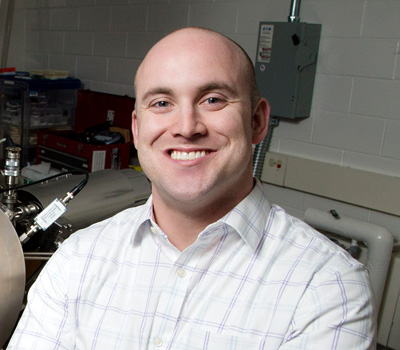Developing materials that will revolutionize the way we live
When you analyze the rapid rate at which technology has advanced in recent years, it would seem as though it will continue almost indefinitely. Contrary to this assumption though, we are reaching maximized levels of efficiency and utility in many of the materials we currently use in manufacturing. Lane Martin, Associate Professor of Materials Science and Engineering at the University of California, Berkeley, is designing new, better, and exotic materials that will allow for more efficient and advanced new products. These new materials, many synthetic, are designed at the fundamental atomic level of structure to perform specific functions. These materials are applicable in many aspects of industry and can be slightly altered to execute several different processes.
Dr. Martin's research has the potential to revolutionize many industries and products. While many of the newly developed products can have several varying applications, three specific current research projects touch on energy and computational problems that will plague future innovation if alternative materials are not developed.
-
Nearly 50-60% of all energy expended in the United States each year is lost as heat (a process otherwise known as entropy) due to inefficiencies in devices and processes. Harvesting even a small fraction of this wasted heat could be a game changing advance. Materials with strong responses to heat, including those that undergo fundamental electrical or magnetic changes when exposed to an external heat source, represent a novel way to collect and utilize this waste heat. In turn, using the exotic materials developed by Dr. Martin, one can create systems that convert this waste heat into usable electrical energy without the need for the moving parts common to modern energy producing systems.
-
Computers and microchips are incorporated into nearly every new consumer device produced today. The amazing advances in computing power we have experienced in our lifetimes have been made possible by the continual refinement of a narrow set of materials; however, there is a limit to the extent to which we can shrink devices based on these materials and we are faced with a potential end to our ever increasing computational power that can be integrated into ever shrinking hand-held devices. To address this challenge, researchers like Dr. Martin aim to replace conventional materials with new materials that could fundamentally change the way we do computation. Whereas current computer logic functions using two responses, so-called 0's or 1s, Dr. Martin is developing new materials that will have the possibility of offering multiple responses - 0's, 1's, 2's, etc. Even one additional channel will greatly increase the computational power without increasing size, allowing for vastly more efficient and paradigm-shifting new devices.
-
As more data becomes available about climate change and it's potential impact on humanity, there is an urgent desire to create new, clean, alternative energy sources. Today the predominant material used in solar panels and computers is the same - silicon - and in both applications scarcity of materials and the needs for special packaging can potentially limit its utility. Dr. Martin and his team are taking a different approach - asking whether one can make a solar panel from Earth-abundant, stable materials derived from rocks? The answer is yes, and by exploring a new class of materials for these solar energy conversion systems Dr. Martin's team is identifying materials that are naturally resistant to weather and the environment, yet when exposed to sunlight will create electrical power just like a silicon solar cell. What's more, the materials being investigated by Dr. Martin can then be immersed in a fluid such as water and use the sun energy to drive a catalytic reaction that will split water into hydrogen and oxygen molecules - which can be stored and used for a clean-burning fuel (the product of this burning is water)! Such technologies would allow for solar energy driven production of clean-burning, storable fuel with high energy densities, and dramatically reduce the production of hydrocarbons - pollutants associated with the burning of traditional fossil fuels - in other words driving us towards a carbon-neutral society.
To satisfy our desire for ever new and changing technology we need a new set of materials to enable these advances. Today though, we are on the verge of maximizing the potential of many of the materials we currently use in various fields of manufacturing. This highlights the importance of discovering and inventing new materials with specified properties designed for specific functions. By designing new materials, their most useful properties can be highlighted, augmented, and enhanced. Additionally, many of the materials Dr. Martin is designing are multi-functional; a material that may absorb heat and produce electricity can also be used to to provide cooling when exposed to an electrical stimulus and these same materials can play a role in new materials for computation, energy, healthcare, and beyond.
Bio
As Associate Professor of Materials Science and Engineering at the University of California, Berkeley, Lane Martin has extended himself far from his humble, blue-collar Western Pennsylvania roots. A second generation college student, Martin was able to channel his natural intuition about the natural world and a hands-on approach to life into a successful career in materials engineering. In his own right, Dr. Martin is in artist, albeit one working at very small length-scales (like those of an atom) and piecing structures together at the atomic level to create new, specialized materials. Much like an artist at the end of the day, Dr. Martin and his team create a new piece of work that they hope will stimulate those around them and spur on new understanding and knowledge.
Outside of the laboratory and classroom, Dr. Martin was a talented football player in high school and continued his sporting career in college, playing running back for Carnegie Mellon University. After completing graduate studies at the University of California, Berkeley, Dr. Martin spent five years at the University of Illinois, Urbana-Champaign as an assistant professor before returned to accept an associate professor position at UC Berkeley. Dr. Martin has received a number of awards for his work:
-
Young Investigator Program Award from the Army Research Office in 2010
-
Faculty Early Career Development (CAREER) Award from the National Science Foundation in 2012
-
Dean's Award for Excellence in Research from the College of Engineering, University of Illinois in 2013
-
Presidential Early Career Award for Scientists and Engineers (PECASE) - the highest honor the nation can bestow on a scientist or engineer at the beginning of his or her career. As part of this award, Dr. Martin traveled to the White House to meet President Obama in 2014.
In addition to nearly 100 publications on his work, Dr. Martin has four patent applications filed under his name:
-
US Patent Application No. PCT/US14/18350 "Light Absorbing Oxide Materials for Advanced Photovoltaic and Photocatalytic Applications and Devices"
-
US Patent Application No. PCT/US12/48326 "Electron Emission Device"
-
US Patent Application No. US 2011/0308580 "Ferroic Materials Having Domain Walls and Related Devices"
-
US Patent Application No. 2011/0133601 "Thin film bismuth iron oxides useful for piezoelectric devices"
In the News
On April 15, 2014, The Science Coalition hosted a Media Roundtable featuring winners of the prestigious Presidential Early-Career Award for Scientists and Engineers (PECASE) from universities across the country.
A group of leading researchers were honored yesterday at the White House as recipients of the Presidential Early Career Award for Scientists and Engineers (PECASE), which is the highest honor bestowed by the United States Government


